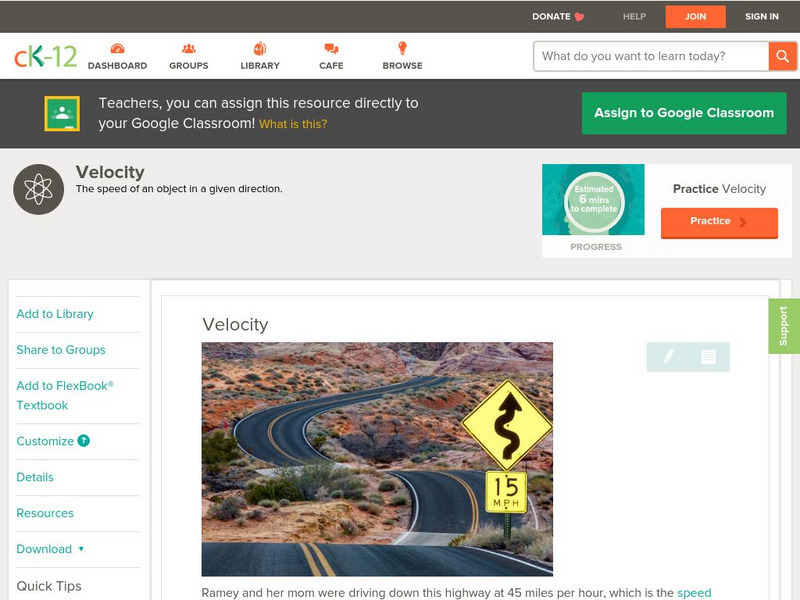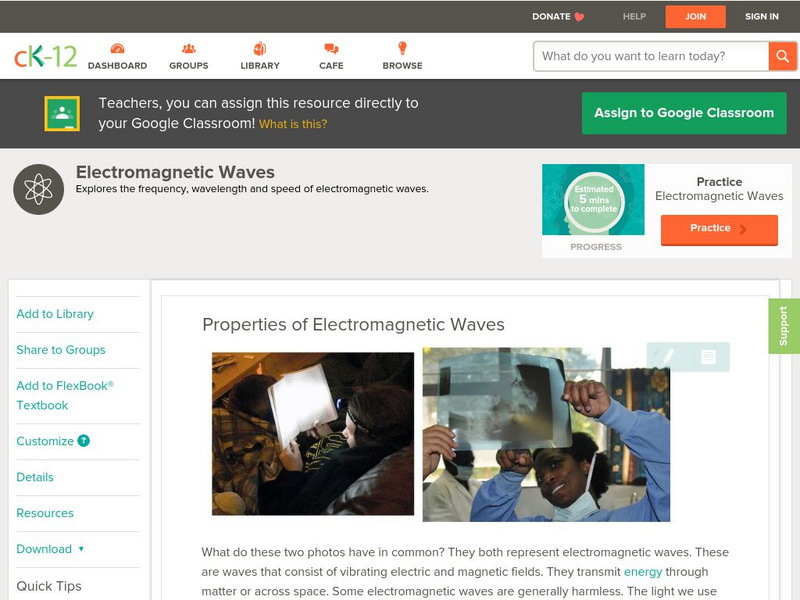Hi, what do you want to do?
OpenStax
Open Stax: College Physics: Flow Rate and Its Relation to Velocity
In this section of the textbook learn how to define and calculate flow rate. Also learn the differences and similarities between flow rate and fluid velocity. Section also relates flow rate to processes in the body like calculating flow...
CK-12 Foundation
Ck 12: Physical Science: Position Time Graphs
[Free Registration/Login may be required to access all resource tools.] How motion and speed can be represented by a distance-time graph and how average speed can be calculated from it.
CK-12 Foundation
Ck 12: Physical Science: Velocity
[Free Registration/Login may be required to access all resource tools.] Difference between velocity and speed, using vector arrows to represent velocity, objects that have different velocities and how to calculate average velocity.
Physics Aviary
Physics Aviary: Practice Problems: Motion on Incline Level 1
Students must calculate the distance an object will move up an incline using Newton's Laws. Mass, angle, gravitational field and initial speed will be generated randomly.
Physics Aviary
Physics Aviary: Practice Problems: Soccer Shot Simple
Students must calculate the maximum distance they can be from an soccer net and still hit a randomly generated target. The speed and angle of the kick will be generated randomly.
Texas Education Agency
Texas Gateway: Physics of Hearing: Ultrasound
By the end of this section, you will be able to define acoustic impedance and intensity reflection coefficient, describe medical and other uses of ultrasound technology, calculate acoustic impedance using density values and the speed of...
Texas Education Agency
Texas Gateway: Physics of Hearing: Doppler Effect and Sonic Booms
By the end of this section, you will be able to define Doppler effect, Doppler shift, and sonic boom; calculate the frequency of a sound heard by someone observing Doppler shift; and describe the sounds produced by objects moving faster...
CK-12 Foundation
Ck 12: Physical Science: Wave Speed
[Free Registration/Login may be required to access all resource tools.] Definition of wave speed and how it is related to wavelength and wave frequency, how to calculate wave speed and how it is related to the medium of a wave.
Physics Aviary
Physics Aviary: Quick Circular Motion Calculations Challenge
This challenge is designed to help students move back and forth from different circular motion ideas. These ideas include frequency, rpm, period, angular speed, linear speed, total distance and total radians.
Physics Aviary
Physics Aviary: Practice Problems: Finding Speed From Impulse Graph Level 1
Students must calculate the speed of a hockey puck based on the graph of force vs. time for the impact between the stick and the puck.
Physics Aviary
Physics Aviary: Practice Problems: Finding Speed From Impulse Graph Level 2
Students must calculate the speed of a hockey puck based on the graph of force vs. time for the impact between the stick and the puck.
Khan Academy
Khan Academy: Average Velocity and Speed Review
How to calculate average velocity and speed in one-dimension in word problems.
Physics Aviary
Physics Aviary: Circular Acceleration
This program gives students a visual representation of why an object moving in a circle at constant speed is accelerating. This program will guide students through a method of calculating the circular acceleration based on the change in...
Physics Aviary
Physics Aviary: Pvc Freefall
This lab was designed to give students practice collecting and analyzing data for the PVC Freefall Lab. Masses are dropped from different heights and the speed of the object as it passes through a photogate is calculated. The...
Physics Aviary
Physics Aviary: Practice Problems: Motion on Incline Level 3
Students must calculate the speed of a block when it returns to its original location on an incline using Newton's Laws. Mass, angle, gravitational field, coefficient of friction and initial speed will be generated randomly.
CK-12 Foundation
Ck 12: Physical Science: Properties of Electromagnetic Waves
[Free Registration/Login may be required to access all resource tools.] The speed of electromagnetic waves, their wavelengths and frequencies and how to calculate wavelength or wave frequency.
Physics Aviary
Physics Aviary: Practice Problems: Ice Bucket Challenge
Students must calculate the maximum and minimum speeds for a bucket whirled in a vertical circle.
Physics Aviary
Physics Aviary: Practice Problems: Ice Bucket Challenge Level 1
Students must calculate the maximum and minimum speeds for a bucket whirled in a vertical circle.
Physics Classroom
The Physics Classroom: Momentum and Collisions: Cart and Brick Interactive
Students analyze a collision between a moving cart and a dropped brick that lands on top of it. They use position-time data to determine the pre- and post-collision speeds of the cart and the brick. The individual momentum values of the...
Physics Aviary
Physics Aviary: Car Acceleration
Calculate the final speed and the distanced covered by a car that is accelerating because of a certain set of forces acting on the car.
Physics Aviary
Physics Aviary: Practice Problems: Motion on Incline Level 2
Students must calculate the distance an object will move up an incline using Newton's Laws. Mass, angle, gravitational field, coefficient of friction and initial speed will be generated randomly.
Physics Aviary
Physics Aviary: Practice Problems: Triangle Problems
Students must show they are able to find the components of a velocity vector and that they can calculate the velocity vector from the components. Students must be able to get 5 in a row correct to receive credit for this assignment.
CK-12 Foundation
Ck 12: Momentum
[Free Registration/Login may be required to access all resource tools.] In this online tutorial students will begin to calculate the momentum of a physical system.
Science Education Resource Center at Carleton College
Serc: Calculating the Speed of Sound
In this physical science lab, students will calculate the speed of sound. They will observe that the speed of sound is constant, regardless of wavelength or frequency, and see the inverse relationship between wavelength and frequency.















